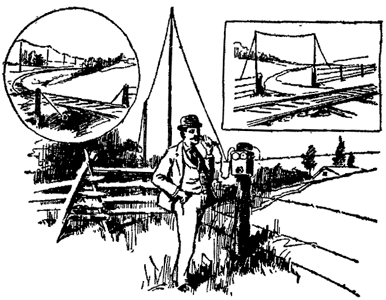Barb-Wire telephone line, Cassius Alley insulator
|
[Newspaper] Publication: The Daily Herald Delphos, OH, United States |
||
|
BARB-WIRE TELEPHONE LINE. Three Towns in Indiana Connected by Using Ordinary Fence Wires.
One of the most novel telephone systems in the world is the "barb-wire" line, which connects the Indiana towns of Anderson, Pendleton and Ingalls. It is fifteen miles in length. Its inventor, builder and sole owner, Cassius Alley of Pendleton, now has six subscribers at $50 a year each. The time is not far distance when there will be tenfold this number. One clothing company at Anderson, with branch stores at Pendleton, and the Wagner glass works, with offices at Anderson and factory at Ingalls are using this barb-wire system in their business affairs exclusively. They use the line frequently. They can convert it into a private line by plugs so arranged that when one party is using the line he can cut out all others except in Mr. Alley's residence, which is used as a central station. Ordinary phones are used with no special strength of battery and there is very little trouble with the lines. In constructing the line, Mr. Alley used the top strand of the barb-wire fence of the Big Four railroad, making the connections with the subscribers with ordinary telephone wire. In some instances where the posts had rotted it was necessary to paint the wire and posts with rubber paint to insulate the wire. This is fairly satisfactory and puts the line in shape to be used as well in wet weather as at any other time. The inventor expects to put to a newly invented form of glass insulator, which is very cheap and the only one yet found that can be used on a fence wire On this line, wagon roads are crossed thirty-seven times and railroads six times. At these crossings the line is either carried through a gas-pipe conduit, with insulated wire or by building bridges, which is done by merely nailing a piece of timber fifteen feet long to the last fence post and extending high enough to allow clearance for traffic. The whole line of fifteen miles was built at a cost of about $100, and the outfit for each house, consisting of receiver, transmitter, battery, call, etc., costs not over $10. The magnet bell call is used. This barb-wire line is connected with the Independent long-distance teletance telephone line at Ingalls, and in this way Indianapolis and Greenfield may be reached by the users of Mr. Alley's system.
The line has been in operation since December and has not been out of order except for a few hours, when a fast train on the railroad struck a cow, threw her body against a fence and broke the wire. A telephone communication, by this simple method, is placed within reach of every community. Farmers who do not have regular telephone outfits and wires leading to their residences are supplied with a small instrument at a very small cost. This little contrivance is so arranged that it can be attached to the main barb wire at any point and thus the farmer is enabled to call up his city merchant, or broker, or lawyer just as well as if he had the ordinary telephone equipment. |
 BARB
BARB